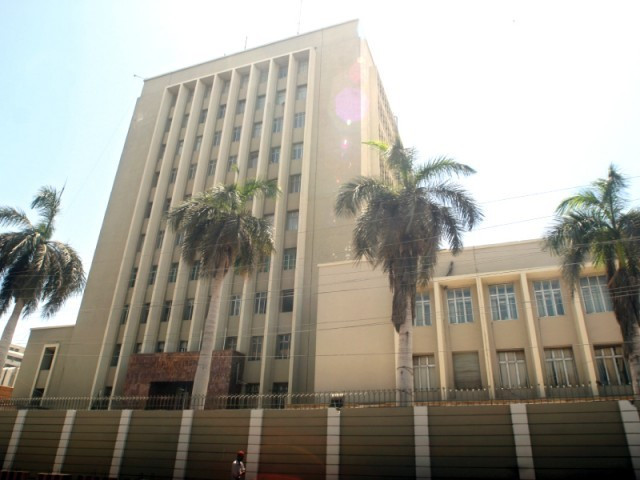Status quo: SBP keeps policy rate unchanged at 6.5%
Decision to keep rate flat based on sharp decline in CPI inflation.

Credit Growth: Rs208.7b is the minor increase witnessed in the private sector credit in 2014-15 as opposed to the rise of Rs371.4 billion in the preceding fiscal year. PHOTO: ATHAR KHAN/EXPRESS
The State Bank of Pakistan (SBP) announced on Saturday it will keep the policy rate unchanged at 6.5% for the next two months.
After the revision of the SBP’s Interest Rate Corridor (IRC) a couple of months ago, the policy rate of 6.5% now represents the newly introduced ‘target rate’ as opposed to the discount rate of 7%.
The discount rate is the effective ceiling interest rate at which commercial banks are allowed to borrow from the central bank’s discount window on an overnight basis. However, the ‘target rate’ is now the policy rate that indicates the SBP’s stance of monetary policy going forward.
Monetary Policy Statement and Monetary Policy Compendium uploaded on website
— SBP (@StateBank_Pak) July 25, 2015
For details:http://t.co/QJZUytz07b
http://t.co/CblBxX35i1
For details on SBP target rate see:http://t.co/Ly3RR4XkyH http://t.co/Lc01neAFo5
— SBP (@StateBank_Pak) July 25, 2015
Following its ‘accommodative’ monetary policy stance, the SBP cut the key interest rate in the economy by 300 basis points in the last fiscal year. Addressing a press conference at the SBP headquarters, Governor Ashraf Mahmood Wathra said the decision to keep the policy rate unchanged is based on a sharp decline in CPI inflation, along with its benign outlook, and improvement in the external account. In addition, the SBP said the reduction in fiscal deficit and continuation of the Extended Fund Facility (EFF) improved the market sentiments, leading the SBP to keep the discount rate at the 42-year record low of 7%.
Market expectations
Prominent brokerage houses had issued notes to their clients last week, saying they expected no change in the SBP’s monetary policy stance. Analysts at AKD Securities, Elixir Securities and Shajar Capital said the SBP would keep the target rate unchanged in view of the price pressures that would likely build up near the end of 2015.
However, money market trends sent mixed signals. Bidders had exhibited more interest in the longer-tenor market treasury bills, which suggests they expected the benchmark interest rate to go down. Similarly, bond yields on all tenors went down in the last two months, which indicated the expectation of a downward revision in the SBP’s policy rate.
Inflation outlook
Without announcing any major change in the SBP’s previous inflation forecast, the SBP governor said some recent developments suggested “slight deviation in the disinflationary trend of 2014-15” in 2015-16.
Referring to the possibility of an increase in energy tariffs in 2015-16 along with an adverse impact of floods on the production of perishable food items, the SBP governor said it could have an upward pressure on inflation going forward.
Commenting on the prospects of growth, Wathra said expected higher consumption in the low-interest rate environment, planned increase in development spending and budgetary incentives for the construction sector could provide some thrust to growth.
“Moreover, implementation of infrastructure projects planned under the China-Pakistan Economic Corridor (CPEC) and addressing structural issues, especially related to energy and security, will create favourable investment environment, which is necessary to sustain economic growth over the medium to long term,” he said.
Despite a substantial decrease in the benchmark interest rate in 2014-15, private-sector credit could not register any notable increase during the last fiscal year.
SBP data shows private-sector credit inched up only Rs208.7 billion in 2014-15 as opposed to the rise of Rs371.4 billion recorded in the preceding fiscal year.
The SBP, however, is optimistic that the construction and real-estate sectors show promise in 2015-16 as indicated by their continued credit uptake.
“The major drag for private-sector credit remains the structural bottlenecks and low commodity prices,” Wathra said, adding that the lagged impact of easy monetary policy of 2014-15 is also expected to positively affect credit growth in the upcoming credit cycle in the first half of 2015-16.
Newly introduced: Explaining the Interest Rate Corridor
The SBP announced its time-bound plan in February to improve its Interest Rate Corridor (IRC) by introducing the ‘target rate’ between the floor and ceiling rates of the corridor to make liquidity management in the interbank market more effective.
The new IRC has replaced the earlier corridor set in place in August 2009 under which the SBP reverse repo rate served as both the policy rate as well as the ceiling rate. But overnight rates close to the policy rate made the ceiling rate less penal and increased the probability of banks availing the SBP discount window more frequently.
This led the SBP to impose penal rates for accessing SBP standing facilities more than seven times during one quarter in 2012. As a consequence, however, the overnight money market repo rate would go above the SBP’s policy rate at times, creating volatility in the interbank market.
Under the new IRC, the ‘target rate’ is fixed between the floor and ceiling of the interest rate corridor. Using liquidity management tools, mainly open market operations and outright sale/purchase of government securities, the SBP now aims to keep the money market weighted average overnight rate close to the SBP target rate.
Addressing a press conference on Saturday, the SBP governor said the implementation of the ‘target rate’ in the last monetary policy announcement led to an increase in both volume and frequency of open market operations (OMO). As a result, the overnight repo rate remained on average 2 basis points below the policy rate of 6.5% in the post-May monetary policy decision. Furthermore, there has been less volatility in the overnight rate in the interbank market, the governor said.
Published in The Express Tribune, July 26th, 2015.
Like Business on Facebook, follow @TribuneBiz on Twitter to stay informed and join in the conversation.









1733130350-0/Untitled-design-(76)1733130350-0-208x130.webp)









COMMENTS
Comments are moderated and generally will be posted if they are on-topic and not abusive.
For more information, please see our Comments FAQ